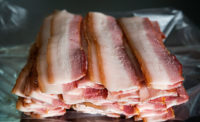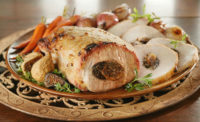This year has been an interesting year for the fresh pork category. Supply shortage predictions have certainly made an impact on the industry, making the market more volatile than previous years.
Earlier this year, pork supplies were predicted to shrink by up to 10 percent. Pork producers countered this forecast by holding hogs back longer and increasing their average carcass weights. Meanwhile, corn prices plummeted, making this an effective strategy. Although supply was predicted to decrease 10 percent, actual pork tonnage decreased by only 1.7 percent.
According to FreshLook Marketing, for the 52 weeks ending July 27, 2014, fresh-pork sales increased 2.1 percent in dollar sales and decreased 3.4 percent in volume compared to the same period a year ago. The average price of pork increased 5.7 percent during this time period.
To help retailers and packer/processors boost pork sales, the National Pork Board focused on several key initiatives in 2014. Studies including The Pork Effect Virtual Shopping Research and the Consumer Decision Tree research allow us, retailers and packers/processors to better understand how consumers shop for fresh pork products and their purchasing process. We also continued to promote the use of the new nomenclature which makes pork cuts more familiar to the average consumer.

The Pork Effect Virtual Shopping Research
The Pork Effect Virtual Shopping Research was the first of its kind to better understand how consumers shop for meat, by taking survey participants through a virtual shopping experience and observing their behaviors. The findings were analyzed to provide insights into opportunities to build incremental sales, explore consumer attitudes toward the meat case shopping experience, in-stock positioning and challenges to purchase.
The study results showed that having a broader assortment of pork along with more pork cuts increased pork sales without impacting the sales of other proteins. Additionally, consumers said they walk away from the meat case or leave the store if they can’t find the package of meat they want. Further, having a well-stocked case is important to consumers, as they expect four packages of a cut in the case. Anything less is considered out of stock.
Consumer Decision Tree Research
The Consumer Decision Tree research was conducted this year to help retailers identify the key impact points that influence consumers’ meat purchases.
The results indicated that more than 50 percent of pork purchasers’ attention is captured by sales signs, and pork purchasers amend their shopping lists based on in-store ads. Of consumers without shopping lists, more than one-third say in-store ads/sales impact their purchase, and half made pork purchases on impulse.
The research also shows the importance of having a fully stocked case: 42 percent of pork purchasers will walk away from the case if the cut they are looking for is not stocked at the case, while 41 percent will switch cuts and 17 percent will switch proteins.
Retailers need to make sure they keep their meat cases well-stocked with a good variety of cuts and keep their display visually appealing and well-organized so packages are easy to find.
New nomenclature for cuts
We also continued to promote new nomenclature for fresh pork cuts. This joint effort started in 2013 with the Beef Checkoff Program and resulted in 18 months of research identifying what, specifically, would help consumers better understand the pork and beef cuts they see every day at the meat case.
The results of the research culminated in changes to the Uniform Retail Meat Identification Standards (URMIS) nomenclature and the development of new label information and other educational tools — all designed to increase fresh-meat sales and reduce consumer confusion. Pork loin cuts adopted beef terminology that consumers recognize (Ribeye Chop/Porterhouse Chop/T-Bone Chop/New York Chop), allowing retailers to drive value from one end of the pork loin to the other.
Options in cooking pork
The National Pork Board recommends grilling pork chops to an internal temperature between 145 degrees (medium-rare) and 160 degrees (medium), followed by a three-minute rest. This temperature drop is pivotal for the pork industry, which has worked for years to promote this change. The temperature guidelines make it easier than ever for consumers to create perfectly cooked pork that is moist and delicious. Retailers are encouraged to educate consumers on this cooking temperature range to ensure they have the best eating experience.
For more information on the National Pork Board’s retail initiatives, visit PorkRetail.org.






Report Abusive Comment